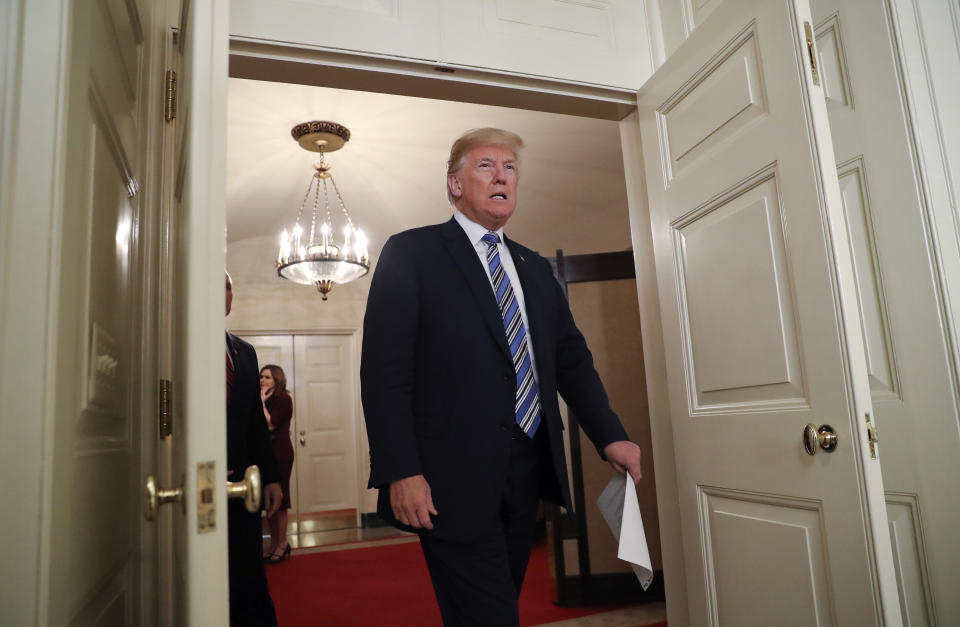Facebook fallout, quarter-end, and GDP — What you need to know for the week ahead
What an ugly week it was.
After a fairly benign start to the action, a Fed rate hike, market fears over Trump’s new trade initiatives, and a complete lack of buyers into the weekend brought the worst week in two years to the stock market.
In the end, the Dow lost 5.7%, the S&P 500 lost 6%, and the Nasdaq dropped 6.5%.
Meanwhile, Facebook (FB) shares fell about 13% as its role collecting and protecting user data came under increasing scrutiny from politicians and the public following the Cambridge Analytica debacle, with CEO Mark Zuckerberg facing calls to answer questions before lawmakers in both the U.S. and the U.K.

Along with Facebook’s decline, other tech giants Alphabet (GOOGL) and Amazon (AMZN) were hammered this week, dropping 5% and 10% respectively, as investors now contemplate a future in which the largely unregulated tech giants see an increasingly hostile political environment.
In the week ahead, the economic calendar’s main highlight will be the third estimate for fourth quarter GDP, due out on Wednesday morning. This report is expected to show the economy grew at an annualized rate of 2.7% in the final three months of 2017, up from the 2.5% pace previously estimated.
This week will also be a holiday-shortened one with markets closed on Friday for Good Friday, and investors will also see the end of the first quarter in the week ahead.
The earnings calendar will be fairly tame, with notable results expected out coming from Red Hat (RHT), Constellation Brands (STZ), Monsanto (MON), and Lululemon (LULU).
Primary market catalysts this week, however, are likely to be any additional developments on trade from the Trump administration or retaliatory moves from China or other trading partners, as well as the market’s recent action itself. Friday’s close on the S&P 500 was 7 points above its February 8 low, and the question for investors this week will be to see if this low holds and if markets can find a way to push higher from here.

Economic calendar
Monday: Dallas Fed manufacturing index, March (33.5 expected; 37.2 previously)
Tuesday: S&P/Case-Shiller home price index, January (+0.6% expected; +0.64% previously); Richmond Fed manufacturing index, March (22 expected; 28 previously); Conference Board consumer confidence index, March (131 expected; 130.8 previously)
Wednesday: Fourth quarter GDP, third estimate (+2.7% expected; +2.5% previously); Pending home sales, February (+2% expected; -4.7% previously)
Thursday: Initial jobless claims (230,000 expected; 229,000 previously); Personal income, February (+0.4% expected; +0.4% previously); Personal spending, February (+0.2% expected; +0.2% previously); “Core” PCE, year-on-year, February (+1.6% expected; +1.5% previously); Chicago PMI, March (62 expected; 61.9 previously); University of Michigan consumer sentiment, March (102 expected; 102 previously)
Friday: Markets closed for Good Friday.
Trump’s tariffs and the stock market
There’s no way around it after the market action seen this past week — Trump’s talk on trade is a threat to the stock market.
Last week, stocks had their worst week in two years (the second time in six weeks, we’d note, that the market earned this designation), as the major indexes all lost more than 5.5%.
And while the initial round of trade actions from the Trump administration — the since-watered down actions on steel and aluminum imports — saw a more muted market reaction, Trump’s announcement to slap tariffs on $50 billion of Chinese imports and the resulting retaliation from the Chinese just hours later has investors a bit more on edge.
And for a president that been more than willing to use the stock market’s rally since his election as a sign of his economic success, one of Trump’s signature accomplishments appears to be imperiled by his own doing.

“Protectionism will cut against the benefits of the recently enacted Tax Cut and Jobs Act,” said Michael Gapen, U.S. economist at Barclays.
“Anti-trade policies, particularly tariffs, act like a tax on consumers and business by raising the cost of trade,” Gapen adds. “By creating uncertainty, they also weigh on asset valuations, which could weaken households’ ability to sustain spending, and they likely reduce the incentive for business to invest. The initial reaction of US equity markets, which fell about 2.5% following the announcement, is consistent with this view and not surprising.” (Emphasis ours.)
Gapen’s colleagues in Barclays’ equity derivatives group found that an across the board tariff on 10% of U.S. imports would completely undue the benefits of tax reform, which has boosted corporate bottom lines and resulted in a record increase in earnings forecasts for the first quarter, according to FactSet.
The estimated 11% cut in 2018 earnings per share from a broad 10% tariff would reverse all of what corporations gained from the Trump tax cuts passed late last year. But this analysis of what is still a tail risk for markets — meaning that the outbreak of an all-out trade war is still unlikely — can’t fully capture what many observers have been most concerned about when it comes to trade tensions, and those are so-called “second order” impacts of a world where a trade war has broken out.
“Our analysis ignores the second order ripple effects of the tariffs due to decline in aggregate output of the global economy relative to expectations,” writes Barclays analyst Maneesh Deshpande.
Deshpande notes that a loss of market share from tariffs won’t just hurt end sellers, but the whole supply chain. Decreased profits will also lead to lower investment. But an overall hit to sentiment from this scenario breaking out likely poses the biggest threat to markets.
“A slowdown is also likely to hit business sentiment which would have its own knock-on effects,” Deshpande writes.
“Although protectionism was one of the four arrows of Trumponomics, it never materialized during the first year in office. Equity valuations reached an all-time high as sentiment improved with the market’s focus on the other three ‘pro-growth’ arrows — tax cuts, deregulation and fiscal expansion. An un-leashing of anti-trade policies and potential of a trade war could reverse the upward trend in valuations.”
And so as was seen in markets this past week, the strong earnings growth backdrop that was supporting valuations also hinged on positive and durable investor sentiment. It now seems clear that sentiment peaked in January, at least temporarily, and events that impact equity valuations — either realized or perceived — now put at risk the continuation of a 2017 stock rally most Wall Street analysts expected to see continue in 2018.
—
Myles Udland is a writer at Yahoo Finance. Follow him on Twitter @MylesUdland
Read more from Myles here:
Trump’s trade moves put his favorite economic report card at risk
The Fed’s big message for markets — don’t worry about our forecasts
The Trump tax cut earned Warren Buffett’s Berkshire Hathaway $29 billion in 2017
Goldman Sachs says U.S. economic data right now is ‘as good as it gets’
One candidate for Amazon’s next headquarters looks like a clear frontrunner


